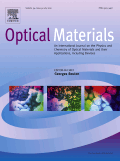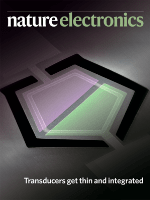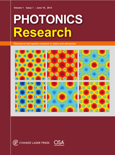
Frontiers of Optoelectronics
Scope & Guideline
Navigating the Frontiers of Light and Matter
Introduction
Aims and Scopes
- Optoelectronic Materials and Devices:
Research on the development and optimization of materials such as semiconductors, insulators, and nanomaterials for use in optoelectronic devices. This includes studies on organic, inorganic, and hybrid materials. - Photonics and Light Manipulation:
Innovative techniques to manipulate light through various optical devices and systems, including photonic crystals, metasurfaces, and nanostructures, aimed at enhancing performance in applications such as sensing, imaging, and communication. - Terahertz Science and Applications:
Exploration of terahertz radiation generation, manipulation, and detection, including its applications in imaging, spectroscopy, and wireless communications. - Advanced Imaging and Sensing Techniques:
Development of new imaging and sensing methodologies leveraging optoelectronic principles, including hyperspectral imaging, real-time monitoring systems, and advanced detection methods. - Energy Harvesting and Conversion:
Investigations into solar cells, light-emitting diodes (LEDs), and photodetectors, focusing on efficiency improvements and novel architectures to enhance energy conversion and utilization. - Integration of Photonics and Electronics:
Research that bridges the gap between photonics and electronics, exploring integrated systems that leverage both domains for advanced functionalities in computing, communication, and sensing.
Trending and Emerging
- Metasurfaces and Light Manipulation:
Recent publications highlight a surge in interest in metasurfaces, which offer unprecedented control over light at the nanoscale, enabling innovative applications in imaging, sensing, and telecommunications. - Quantum and Topological Photonics:
Research exploring quantum effects and topological phases in photonic systems is emerging as a significant theme, with implications for robust communication and advanced materials. - Integrated Photonic Devices:
There is a growing emphasis on the integration of photonic and electronic components to create multifunctional devices, reflecting the industry's move towards smaller, more efficient systems. - Advanced Energy Solutions:
Efforts to enhance the efficiency and stability of energy-harvesting devices, particularly in solar technologies and light-emitting diodes, are becoming a focal point in recent studies. - Artificial Intelligence in Optoelectronics:
The incorporation of AI and machine learning techniques in designing and optimizing optoelectronic systems is gaining traction, facilitating advancements in various applications from imaging to communication.
Declining or Waning
- Traditional Photonic Devices:
There has been a noticeable decrease in publications focusing on conventional photonic devices such as simple lasers and basic optical components, as researchers shift towards more innovative and integrated approaches. - Basic Optical Materials Research:
While foundational studies are essential, there is a gradual decline in papers that focus solely on the characterization of basic optical materials without application-oriented research, as the field moves towards applied and multifunctional materials. - Non-Terahertz Microwave Photonics:
Research in microwave photonics that does not involve terahertz applications has seen reduced attention, likely due to the increasing interest in terahertz technologies and their broad applications. - Conventional Imaging Techniques:
The focus on standard imaging techniques is waning as new methodologies, such as advanced hyperspectral and computational imaging, gain traction and attract more research interest.
Similar Journals

Laser & Optoelectronics Progress
Transforming Discoveries into Technological EvolutionLaser & Optoelectronics Progress, published by the Shanghai Institute of Optics and Fine Mechanics, Chinese Academy of Sciences, is a pivotal journal dedicated to advancing the fields of optics and electronic engineering. With an ISSN of 1006-4125, this journal provides a comprehensive platform for groundbreaking research focused on lasers, optoelectronic devices, and their practical applications. Although currently categorized in Quartile 4 in both Atomic and Molecular Physics, and Electrical and Electronic Engineering, it serves as an essential resource for disseminating innovative findings and techniques to a global audience. Researchers and scholars will find value in its commitment to fostering collaboration and knowledge-sharing amidst the rapidly evolving landscape of optical sciences. As a key contributor to the academic community, Laser & Optoelectronics Progress aims to bridge gaps between theory and practice, ultimately catalyzing advancements that enhance technological evolution in the field.

npj Flexible Electronics
Driving Innovation in Multidisciplinary Applicationsnpj Flexible Electronics, published by NATURE PORTFOLIO, is a premier open-access journal dedicated to the rapidly advancing field of flexible electronics. Since its inception in 2017, the journal has gained significant recognition, boasting impressive rankings as a Q1 journal in both Electrical and Electronic Engineering and Materials Science based on the 2023 metrics. With its E-ISSN 2397-4621, the journal serves as an essential platform for researchers, professionals, and students alike, facilitating the dissemination of high-quality research articles, reviews, and insights that drive innovation across multidisciplinary applications. Operating from its base in Berlin, Germany, and characterized by a robust impact within the academic community, npj Flexible Electronics plays a critical role in shaping the future of electronic materials and devices. The journal offers comprehensive open access options, ensuring that cutting-edge research is readily available and widely disseminated, fostering collaboration and engagement within the global research community.

OPTICAL MATERIALS
Connecting Science and Engineering through LightOPTICAL MATERIALS is a peer-reviewed journal published by Elsevier, focusing on the intricate field of optical materials within various scientific domains including atomic and molecular physics, electronic engineering, and chemistry. With an impact factor indicative of its relevance, it ranks in the Q2 category across multiple areas such as Electrical and Electronic Engineering, and Inorganic Chemistry, highlighting its critical position in advancing research and innovation. Established in 1992 and continuing its contribution until 2024, this journal serves as a vital resource for researchers and professionals aiming to disseminate significant findings in material sciences, particularly those related to optical properties and applications. While it does not offer open access, the journal remains essential for academia and industry alike, ensuring the continued exchange of valuable knowledge in this rapidly evolving field.

Photonics
Exploring the Frontiers of Light and TechnologyPhotonics, an esteemed journal published by MDPI, is a leading platform for researchers in the fields of atomic and molecular physics, optics, and instrumentation. Since its inception in 2014, the journal has fostered open access to cutting-edge research, facilitating knowledge dissemination in these dynamic disciplines. With its Q2 ranking in the 2023 Scopus metrics for various categories, including radiology, nuclear medicine, and imaging, Photonics represents a crucial academic resource for professionals and students seeking to advance their understanding and expertise. Located in Basel, Switzerland, the journal plays a pivotal role in bridging theoretical and practical approaches to photonic technologies. Researchers are encouraged to contribute their findings, thereby enriching the journal’s impact and relevance in the global scientific community through collaboration and innovation.

Nature Electronics
Empowering the Electronics Community with KnowledgeNature Electronics is a premier journal in the field of Electrical and Electronic Engineering, published by NATURE PORTFOLIO. Established in 2018 and converging until 2024, it has swiftly positioned itself as a leading platform for groundbreaking research, holding a prestigious Q1 ranking in multiple categories including Electronic, Optical and Magnetic Materials, and Instrumentation according to the latest 2023 evaluations. The journal boasts an impressive Scopus ranking, securing the top position in Instrumentation and showcasing exceptional standings in both Electrical Engineering and Materials Science. With a commitment to disseminating high-quality research, Nature Electronics offers insightful access to the latest innovations and advancements in the electronics domain, making it an essential resource for researchers, professionals, and students alike. Engaging with this journal enables readers to stay at the forefront of technological progress and fosters discussion on the future of electronic materials and devices.

Light-Science & Applications
Shining a Light on Groundbreaking ResearchLight-Science & Applications is a prestigious open-access journal published by SPRINGERNATURE, dedicated to advancing the fields of Atomic and Molecular Physics, Optics, and Electronic, Optical, and Magnetic Materials. Established in 2012 and located in the United Kingdom, this journal has rapidly gained recognition, evidenced by its impressive 2023 rankings; it is situated in Q1 within its categories, boasting a rank of #5 out of 224 in Physics and Astronomy and #8 out of 284 in Materials Science, placing it in the esteemed 97th percentile. It is committed to disseminating high-quality research that explores innovative applications of light and materials science, making it an invaluable resource for researchers, professionals, and students alike. As an open-access platform, Light-Science & Applications ensures that its research is freely accessible, fostering collaboration and knowledge exchange within the scientific community. With its converged years spanning from 2012 to 2024, the journal remains at the forefront of impactful developments in light science.

Photonics Research
Advancing Knowledge in Light and MaterialsPhotonics Research, published by Chinese Laser Press, is a premier international journal that aims to disseminate cutting-edge research and advancements in the field of photonics, encompassing areas such as atomic and molecular physics, optics, and materials science. Since its inception in 2013, this journal has established itself as a vital resource for academics and professionals, reflected in its impressive Q1 rankings in both Atomic and Molecular Physics, and Optics (15/224) and Electronic, Optical and Magnetic Materials (26/284) as per Scopus, underscoring its influence within the scientific community. With substantial contributions to the field, Photonics Research continues to foster innovation and collaboration among researchers, serving as an essential platform for the publication of high-quality studies that push the boundaries of knowledge. The journal operates on an open-access model, ensuring that research is readily available to a global audience, thereby enhancing its accessibility and impact. Whether you are a researcher, student, or professional, engaging with this journal offers a significant opportunity to stay at the forefront of photonic technologies and ideas.

Nonlinear Optics Quantum Optics-Concepts in Modern Optics
Pioneering Insights in Modern Optical ResearchNonlinear Optics Quantum Optics-Concepts in Modern Optics is a specialized journal published by OLD CITY PUBLISHING INC, focusing on the forefront of research in nonlinear optics and quantum optics. With an ISSN of 1543-0537 and an E-ISSN of 1944-8325, this journal serves as a pivotal platform for the dissemination of innovative concepts and findings in modern optics, significant for both theoretical exploration and practical applications. Established in 2003, the journal's scope encompasses critical areas such as atomic and molecular physics, optical materials, and instrumentation, attracting submissions from a diverse range of interdisciplinary fields. While the journal currently maintains a Q4 ranking in several categories, it continues to strive for higher visibility and impact in the academic community. Researchers and students alike will find valuable insights and contributions that foster advancements in optical science and engineering. With an emphasis on rigorous peer-review, Nonlinear Optics Quantum Optics-Concepts in Modern Optics is committed to enhancing the understanding and application of nonlinear optical phenomena in various technological domains.

OPTICA APPLICATA
Exploring the Frontiers of Optics and ApplicationsOPTICA APPLICATA, published by Wroclaw University of Science and Technology, is a crucial platform for advancing knowledge in the fields of Atomic and Molecular Physics and Optics. With an ISSN of 0078-5466 and an E-ISSN of 1899-7015, this journal serves as a vital resource for researchers, professionals, and students seeking to explore the latest developments and applications in optical science and engineering. Although currently categorized in the fourth quartile in both Atomic and Molecular Physics and Electronic, Optical and Magnetic Materials, its commitment to publishing high-quality research articles, reviews, and technical notes remains unwavering. The journal covers diverse topics from practical applications to theoretical insights and fosters a collaborative environment for global contributors. While it does not offer an open access option, the journal is accessible through university libraries and institutional subscriptions. With an eye towards bridging academic research with real-world applications, OPTICA APPLICATA is well-positioned to influence advancements in photonics and materials science through ongoing issues from 1988 to 2024.

JOURNAL OF OPTOELECTRONICS AND ADVANCED MATERIALS
Illuminating the Path of Scientific Discovery in OptoelectronicsJOURNAL OF OPTOELECTRONICS AND ADVANCED MATERIALS, published by the NATL INST OPTOELECTRONICS in Romania, is an esteemed academic journal dedicated to disseminating innovative research in the fields of optoelectronics and advanced materials. With an ISSN of 1454-4164 and E-ISSN 1841-7132, the journal provides a platform for researchers to share their findings and technological advancements from 1999 to 2024. Despite being placed in the Q4 quartile across several categories—including Atomic and Molecular Physics, Condensed Matter Physics, and Electrical and Electronic Engineering—the journal serves as an essential resource for highlighting significant developments in its respective fields. Researchers and professionals may find valuable insights that foster collaboration and inspire further investigation, thereby contributing to the continuous evolution of optoelectronics and materials science.